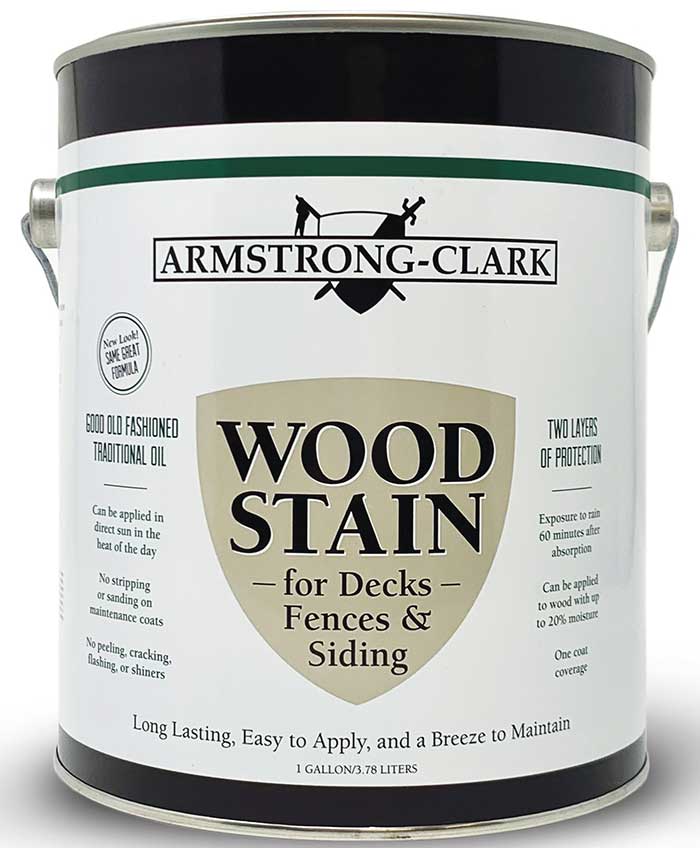There are two main differences between wood stains, those that penetrate the wood and those that form a protective film on top of the wood. The film forming wood stains have a reputation of not holding up as well as penetrating stains. They are prone to peeling and flaking and are traditionally more difficult to maintain. Penetrating wood stains protect by diving below the surface and into the wood pores so there is no film atop the surface. Penetrating wood stains repel water and reflect UV rays before the can do damage. In addition, they are not prone to peeling, they simply fade and wear off before needing to be recoated and are much easier to maintain in this sense.
One of the best penetrating stains on the market is Armstrong Clark wood stain. To understand why Armstrong Clark penetrates wood so well you have to look at the formula. Most deep penetrating stains such as Armstrong Clark are oil based semi-transparent formulas. This is customarily the best type of formula for excellent penetration unlike acrylic or water-based formulas that do not penetrate as well but there are some exceptions.
In addition to being a semi-transparent oil based stain, Armstrong Clark is a specially designed formula that achieves excellent penetration with vegetable oils and transparent oxide pigments. It is a blend of both nondrying and drying oils. The nondrying oils are specifically designed to dive into the wood to replace the wood’s lost natural oils. This helps with wood conditioning and adds flexibility to the wood. The drying side of the formula remains on top of the wood surface to trap in the nondrying oils while creating a dry to the touch barrier of protection. This technology makes Armstrong Clark one of the best-penetrating wood stains.
Replacing the lost natural oils of the wood conditions and rejuvenates the fibers to help reduce wood cracking, splitting and warping that can occur when older wood dries out and becomes brittle. Armstrong Clark stain also contains special water repellents, solvents, and mildewcides that are naturally mold and mildew resistant.




Thinning Pigment Out. Can you tell me what I can add to Armstrong Clark Semi Transparent Cedar to thin it out. Specifically, after using half contents of 5 gallon stain, I added the separate single gallon of the same (cedar) but the pigment was thicker so now its taking on a more brown tone as I do the spindles. What is a legitimate product to add and make it thin; return to more of the orange tone?
You cannot thin the AC stain. Sorry.
My deck is all prepped and sanded. No previous stain on deck. I was going to stain tomorrow however it rained at 1600 hours for an hour. No rain in the forecast for next four days. Should I wait another day before staining.
Yes.
We have a log home and just replaced the big log support posts for the roof of our deck with hand-peeled pine logs. They have been installed for almost 3 months in hot weather with extremely low humidity in SW CO. We cleaned and brightened with Restore-a-Deck and stained the 1st log today with your Cedar Semi-Transparent stain. The pine post is a lot lighter than the Cedar posts under the deck that we also stained today. We would like to darken the color to more closely match the other logs. Can we apply a 2nd coat in the near term or what would you suggest?
Thanks, Alisa
You can apply another coat but not sure if it will darken it enough. You might need to mix a darker color of the AC into your semi cedar color for those pine posts. You will have to play with the ratios though on this.
Thanks – do we need to wait a certain amount of time before applying a 2nd coat?
No, you can do a light coat now.
I applied the semi-transparent cedar 11 months ago to a treated pine deck. I did my best to observe the instructions RE: coating, dry time, and even purchased a moisture meter. With all that said I am very satisfied with your product and I am sure with future re-coats the eveness of the stain will improve. However I have noted that on one or two horizontal boards there appears to be “bleeding” of some substance. The initial color appears to be similar to the stain which then develops an ash type appearance. There is also a stage where this substance takes on a tar consistency. What is your recommendation to remove this substance. Do I scrape it off or lightly sand with a subsequent retouch of the stain or none of the above? Thanks in advance for your input. Greg Luecht
That is sap leaching from the wood. Try to sand off and touch up with the AC stain.
Thanks so much!